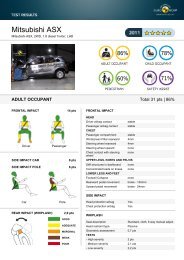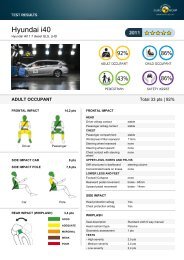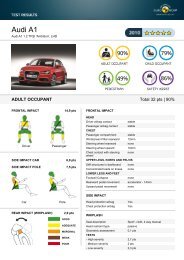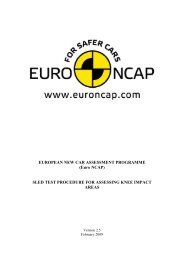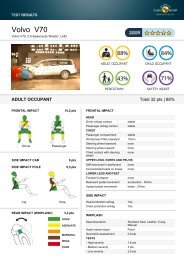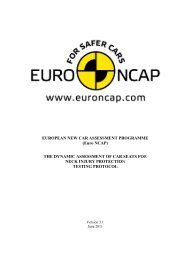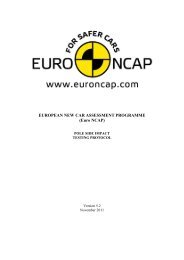Pedestrian Test Protocol - Euro NCAP
Pedestrian Test Protocol - Euro NCAP
Pedestrian Test Protocol - Euro NCAP
Create successful ePaper yourself
Turn your PDF publications into a flip-book with our unique Google optimized e-Paper software.
5 HEADFORM VERIFICATION TESTS<br />
5.1 Verification <strong>Test</strong>s<br />
5.1.1 The vehicle sponsor will fund 10 verification tests in the headform area.<br />
5.1.2 The vehicle manufacturer has the option of sponsoring up to 10 additional headform<br />
verification tests. These are in addition to any blue points and those funded by the<br />
sponsor. Where this is the case, the vehicle manufacturer must inform <strong>Euro</strong> <strong>NCAP</strong> of<br />
the number of tests when predicted data is provided.<br />
5.1.3 The location of all verification tests will be selected at the same time and at random by<br />
the <strong>Euro</strong> <strong>NCAP</strong> Secretariat regardless of the test sponsor.<br />
5.1.4 Only those grid points on defaulted grid positions or those coloured blue will be<br />
excluded from the randomly selected points. All other grid points are eligible for<br />
selection.<br />
5.1.5 There is no restriction as to the location of the randomly selected tests. <strong>Test</strong>s to<br />
adjacent impact locations are acceptable provided that permanent vehicle damage<br />
would not influence other test results.<br />
5.1.6 Where damage from already tested grid points affects other verification tests, the<br />
Secretariat will be informed and will take a decision on how to proceed.<br />
5.1.7 The results of all verification tests will be used in the calculation of a correction<br />
factor.<br />
5.2 Headform <strong>Test</strong>s<br />
5.2.1 The selected grid point shall be treated as the aiming point for the headform impactor,<br />
with active bonnets in the undeployed position.<br />
5.2.2 The centreline of the headform impactor shall be directly in the line of flight toward the<br />
aiming point. See Figure 21.<br />
5.2.3 The effect of gravity shall be considered when positioning the propulsion system for<br />
test. Under the influence of gravity the headform will deviate from the trajectory it has<br />
initially when leaving the propulsion system.<br />
5.2.4 Gravity must be taken into account in order to establish the correct trajectory for the<br />
headform. The determination of where to position the firing mechanism will require the<br />
following information:<br />
Headform diameter<br />
Distance that the headform must travel after leaving the propulsion system<br />
Required angle of impact to horizontal<br />
Angle of the bonnet top at the point of impact<br />
Required impact velocity<br />
5.2.5 Using the above information calculate the distance from the aiming point to ensure that<br />
the required correct trajectory is established. The angle to which the propulsion system<br />
should be set and the velocity that the propulsion system must give to achieve the<br />
required velocity at impact and the required angle of incidence at impact must also be<br />
calculated.<br />
Version 7.0<br />
March 2013<br />
27



